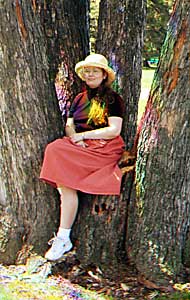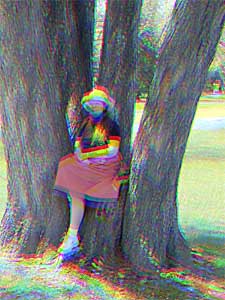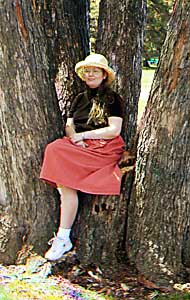It used to be the only way to get color. It’s still the way most color is reproduced (offset printing, mostly). It’s what really goes on inside chromagenic papers. And it’s well supported in PhotoShop and other modern image manipulation programs.
But it’s still weird.
Whose Fault Is It?
What really kicked me off was the photos of Sergei Mikhailovich Prokudin-Gorskii, as restored and displayed in the Library of Congress exhibit. The technical quality of the photos is superb, and they’re also good artistically, and of considerable historical interest. Go look at them!
It seems that Sergei was photographer to the Russian Tsar. In 1909-1912, and in 1915, he traveled around Russia (sometimes in his special photographer’s rail car) and took pictures.
That’s pretty neat to begin with; but what really caught people’s attention was that he used a special camera which let him take three exposures on a long, thin, glass-plate negative, through red, green, and blue filters. In other words, he was capturing the color information. He used it to project the photos as slides, in color, using a three-lens projector with color filters. We can use it to recover the color as well.
Given the dates and descriptions, these would be dry-plate glass negatives. I believe the sensitivity would have been between ISO 6 and ISO 20, very roughly, by today’s standards. That’s slow, but outdoors in good light he would still have been shooting somewhere around 1/15 second at f8 — slow but not completely impractical. The camera, of course, would have been on a sturdy tripod.
What’s the Problem?
The first obvious discussion was how could he have gotten the subjects to hold still enough for him to make three exposures manually, moving the plate and changing filters in between? Well, first, we don’t know for sure that he did; we don’t have his camera or any good description or diagrams. But that’s probably what he did.
So that would have taken somewhere from 3 to 30 seconds, probably. Could that work?
Hmmm. I have a camera. I have PhotoShop. I can certainly do things his way and see what happens. It won’t mean anything about how fast he could work his camera, mine is too different; but it will show whether subjects can hold still well enough.
How Did I Test It?
I used a fairly bizarre procedure. I shot three shots in fairly succession (about 10 seconds) using my Epson 850Z digital camera.
Each shot was in full color, that being the way the camera works.
Then I brought the pictures into PhotoShop and extracted one color layer from each of the three photos — red from the first, green from the second, blue from the third. I was taking advantage of the built-in color filters that the camera uses to take pictures in the first place. I could have put the camera in B&W mode and put color filters in front of the lens, but I don’t have the filters handy, so I would have had to buy them (spending both time and money).
So now I have what Sergei started with, and all I have to do is put them back together.
I didn’t put the camera on a tripod — both because I’m lazy and this saved carting the tripod along on a walk around Lake Calhoun, and because that would have made the registration so precise there wouldn’t have been much challenge. I did use a beanbag, and convenient trees and benches to steady myself.
How Well Does It Work?
Pretty darned well, actually.
Here’s an example:
| red | green | blue |
 |
 |
 |
First composite:
This looks pretty bad, but actually it’s just some simple alignment problems, in the range of a dozen pixels in various directions at the original resolution.
After alignment:

(and cropping; and some contrast adjustment).
You can see some large rainbow patches on Rachael’s blouse, and on the ground and the tree trunks. But most of the rest of the picture looks about right. The big rainbow patches are where the sun is shining through tree branches. It’s fairly breezy, and the sky is party cloudy. In other words, this sort of picture, where the colors are sampled a few seconds apart, is going to have that sort of artifacts in it on that sort of day.
After removing some of the color artifacts:
In this case, since many of them fell on the neutral-colored tree bark, I just used the desaturate tool a lot. I also did some masking to improve a yellow-blue misalignment along the edge of the arm. There’s still some down in the grass, which I didn’t try to fix.
Another Example, With Water
One of Sergei’s original photographs that occasioned the most
discussion (at least on rec.arts.sf.fandom) was this one, which shows a man with a pole standing on a ferry. The surface of the water shows some very strange, oily-looking color and texture. Some of us hypothesized that this was the result of time differences between when the three colors were sampled.
To check, I shot a picture including some water, being fairly heavily disturbed by the wind at the time.
| red | green | blue |
 |
 |
 |
Again, the unaligned composite doesn’t work very well (this was without tripod again):
However, again, with some adjustment (I used a rotation as well as two shifts, this time), it comes out reasonably well:
And the water displays a very similar strange color and texture; enough to convince me that our theory about the water in the original picture is correct. You can also see some similar effects in the tree leaves, which were being blown quite a bit by the wind.
I wonder if the people who performed the restoration corrected color separation artifacts in some cases? For example, with grass, you could pretty much remove the color and replace it with the proper grass-green, and nobody would notice. I don’t think you could do that for the water.



